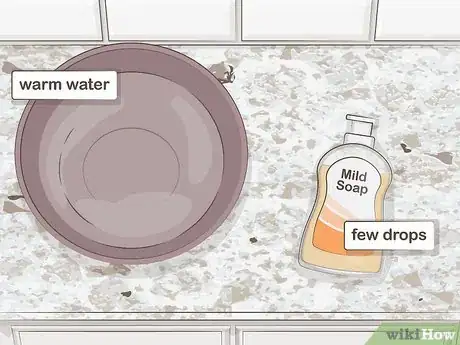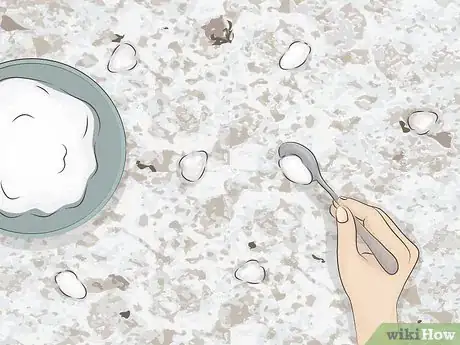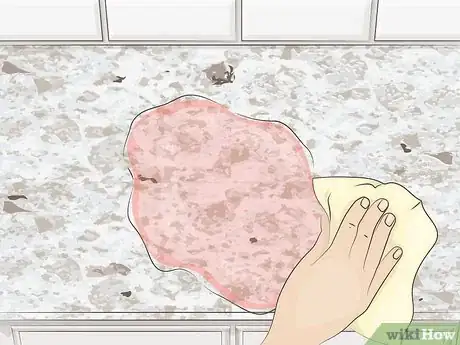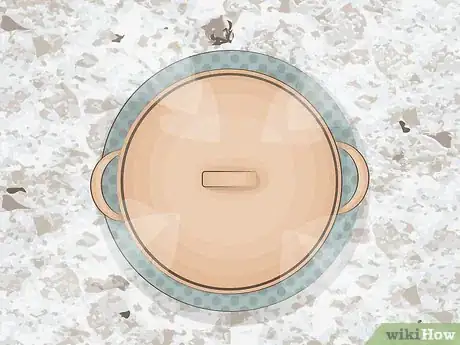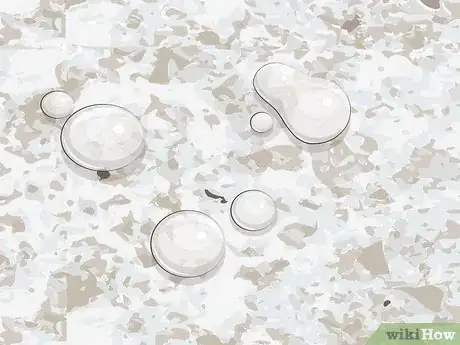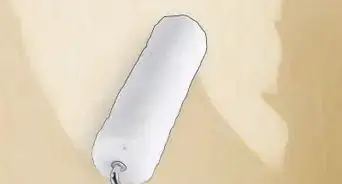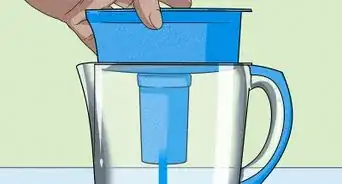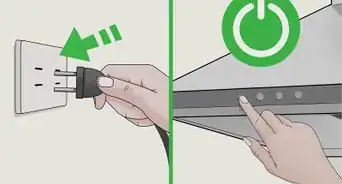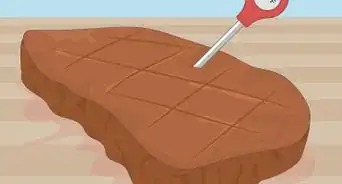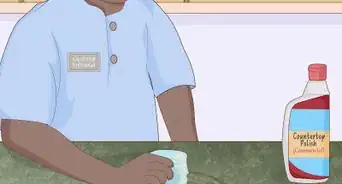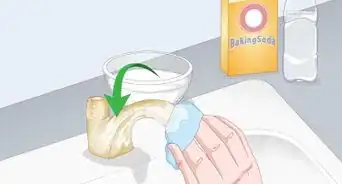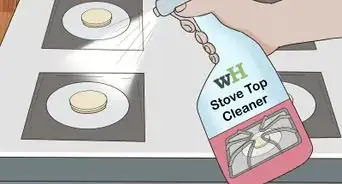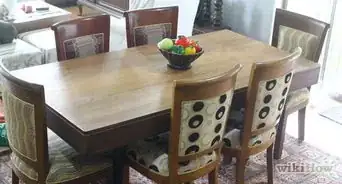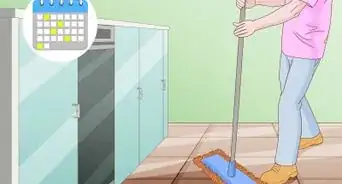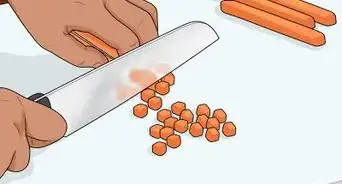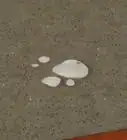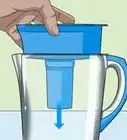This article was co-authored by Michelle Driscoll, MPH. Michelle Driscoll is the Owner of Mulberry Maids, which is based in Fort Collins, Colorado. With five years of experience, her business specializes in cleaning homes and small offices. She holds a Masters in Public Health from the Colorado School of Public Health. Additionally, Mulberry Maids has an A+ rating from the Better Business Bureau.
wikiHow marks an article as reader-approved once it receives enough positive feedback. In this case, 90% of readers who voted found the article helpful, earning it our reader-approved status.
This article has been viewed 515,992 times.
Granite countertops look luxurious when they are shiny and new! If your countertop is looking dull or less than impressive, a simple polish will do the trick. Always clean the countertops before you start polishing to get rid of any spills or stains. Then buff the countertops with either a baking soda paste or a retail granite cleaner to get a nice, polished look. Keep your countertops protected by cleaning up spills immediately and using heat-resistant mats.
Steps
Cleaning and Buffing the Countertops
-
1Mix together warm water and mild soap to make a granite cleaner. Before you start polishing granite, it needs to be free of spills and stains. Fill up a bucket or a sink with warm water. Add a few drops of mild soap like dish detergent and agitate the water to make it bubbly.[1]
- Although warm, soapy water is very effective, you can also purchase specialty granite cleaners for everyday cleaning if you prefer.[2] As another option, you can use a 50/50 solution of isopropyl alcohol and warm water in place of soap and other cleansers.[3]
- Never use harsh chemicals on granite. Although granite is a hard-wearing material, it needs to be treated gently to keep it looking good. Avoid products that contain lemon, vinegar, lime, ammonia, bleach, or glass cleaners, as these chemicals can break down the sealant and damage the granite over time.
-
2Use the soapy water to clean the countertop. Dip a cleaning cloth into the warm water and wring it out to remove the excess water. Use the cloth to wipe away crumbs, spills, and stains from the whole countertop. It’s important that it’s completely clean before you add the polish.[4]
- Microfiber cloths or nubby washcloths are ideal for cleaning granite.[5]
Advertisement -
3Dry the countertop with a microfiber cloth. Get a dry microfiber cloth and remove all of the excess soapy water. Work in a circular motion and go over the whole countertop. You may need to swap the microfiber cloth for a dry one if it gets too wet.[6]
- Drying the countertop thoroughly prevents streaking.[7]
- Alternatively, you can use a terry cloth towel instead of a microfiber cloth.
-
4Make your own polish using baking soda for an easy remedy. Get a small bowl, baking soda, warm water, and a fork. Mix together 3 parts baking soda to 1 part water until the mixture is smooth and a thick paste forms. Try to get rid of any lumps before you use the paste.[8]
- Baking soda is also great for removing stubborn stains from granite.
-
5Buy a retail granite polish to get the best shine. You can find granite polish at many home improvement and kitchen stores. Always read the label to ensure that the product is suitable for your countertop before you buy it.[9]
- Avoid general-purpose polishing products, as these can damage granite.
-
6Apply the polish to the countertop. Place a thin, even coating of the baking soda paste or retail granite polish onto the countertop. If you are using baking soda paste, place small dollops of it across the countertop using a spoon. For retail granite polish, simply spray the product lightly over the countertop and let it sit for the specified amount of time, which is usually 2-3 minutes.[10]
- If you are using a retail granite polish, read the manufacturer’s directions carefully first and always follow all of the instructions.
-
7Buff the countertop with the polish using small, circular motions. Get a clean, soft cloth and begin to work the polish into the granite. Start in a corner and work your way evenly over the countertop. Rub the polish into the countertop in small circles and make sure to buff the edges too.[11]
- It’s important to always use a very soft cloth for buffing, as anything more abrasive could scratch the granite.
-
8Wipe off the polish with a damp cloth to get a streak-free finish. Streaks can easily ruin the appearance of beautifully polished granite! Get a soft cloth and dampen it very lightly with warm water. Use the cloth to wipe down the countertop, removing any remaining baking soda paste or retail granite polish.[12]
- If you notice any excess water on the countertop after you have wiped it down, use another cloth to dry it off.
-
9Get the granite polished professionally if there are deep scratches. In most cases, your granite countertop will polish up nicely using simple cleaning agents. However, sometimes the granite can be too deeply scratched or damaged for home remedies to work. Contact a granite restoration professional to get your granite countertop professionally polished and looking as good as new! [13]
- Professionals use specialty tools and either wet or dry polishing techniques on the granite. These techniques are only recommended for professionals to use, as they can cause irreversible damage if they are done incorrectly.
Preserving Granite
-
1Clean up spills immediately to avoid stains and marks. Liquids that are left on granite for too long can cause dark, shadow-like marks to form. Similarly, bright-colored beverages can stain light granite countertops. Get into the habit of wiping up spills with a soft cloth as soon as they occur.[14]
-
2Buff the granite with cooking oil to provide shine and stain resistance. Apply cooking oil to a clean cloth, then make circular motions across the surface of the countertop. Use gentle pressure as you buff the surface. This will create a nice shine on your granite and temporarily reduce the risk of staining, as spills won't be able to soak into the granite as easily.[15]
- Repeat this periodically, such as daily or once a week, depending on your preferences.
- Use whatever oil you typically use for cooking. For example, you can use vegetable oil, olive oil, or avocado oil.
-
3Use a cutting board to prevent scratching the granite. Although granite is very hard-wearing, it can still be damaged if you regularly cut straight on the surface. Always use a chopping board when you are preparing food and try not to leave any sharp objects directly on the countertop.[16]
- This will also help to protect your knives and keep them sharp.
-
4Place hot objects on a heat-resistant surface on the countertop. Hot pots, pans, hair straighteners, and curling irons can all cause micro-scratches to form. Keep a silicone, heat-resistant pad or an insulated mat within easy reach on the countertop.[17]
- Micro-scratches form when the granite experiences a sudden change in temperature.
- Hot objects can also cause the sealant to break down more quickly.
-
5Keep cosmetics off the countertop to prevent chemical damage. Makeup and nail polish contain chemicals that can tarnish the granite and break down the sealant with long-term exposure. Place these products on a tray or a mat, or leave them in a cabinet instead.[18]
-
6See if water beads form on the countertop to check the sealant. Granite countertops are sealed to protect the stone from being weakened and damaged from everyday use. Pour a few drops of water onto the countertop and check that water beads form, as this indicates that the seal is working properly. If the water soaks into the countertop, apply a granite seal or contact a granite restoration professional to get it resealed.[19]
- Make sure you do this sealant test before you do any buffing and cleaning of the granite. Otherwise, you may damage the sealant or the granite.
- Granite countertops usually need to be resealed every 5-10 years.
- You can clean and polish the granite if the countertop needs to be resealed, however, it’s best to act promptly to avoid any damage.
Expert Q&A
Did you know you can get expert answers for this article?
Unlock expert answers by supporting wikiHow
-
QuestionMy granite countertops are "pocked" in some spots. Can they be re-polished to smooth the surface?
 Michelle Driscoll, MPHMichelle Driscoll is the Owner of Mulberry Maids, which is based in Fort Collins, Colorado. With five years of experience, her business specializes in cleaning homes and small offices. She holds a Masters in Public Health from the Colorado School of Public Health. Additionally, Mulberry Maids has an A+ rating from the Better Business Bureau.
Michelle Driscoll, MPHMichelle Driscoll is the Owner of Mulberry Maids, which is based in Fort Collins, Colorado. With five years of experience, her business specializes in cleaning homes and small offices. She holds a Masters in Public Health from the Colorado School of Public Health. Additionally, Mulberry Maids has an A+ rating from the Better Business Bureau.
Founder, Mulberry Maids
-
QuestionWill water seep into the granite and ruin it?
 Michelle Driscoll, MPHMichelle Driscoll is the Owner of Mulberry Maids, which is based in Fort Collins, Colorado. With five years of experience, her business specializes in cleaning homes and small offices. She holds a Masters in Public Health from the Colorado School of Public Health. Additionally, Mulberry Maids has an A+ rating from the Better Business Bureau.
Michelle Driscoll, MPHMichelle Driscoll is the Owner of Mulberry Maids, which is based in Fort Collins, Colorado. With five years of experience, her business specializes in cleaning homes and small offices. She holds a Masters in Public Health from the Colorado School of Public Health. Additionally, Mulberry Maids has an A+ rating from the Better Business Bureau.
Founder, Mulberry Maids
-
QuestionHow do I remove water spots?
 Community AnswerApply a mixture of olive oil and salt. Let sit for a few minutes before wiping off.
Community AnswerApply a mixture of olive oil and salt. Let sit for a few minutes before wiping off.
Warnings
- Don’t attempt to polish a granite countertop yourself using power tools or harsh abrasives, as it’s very easy to accidentally cause damage. If your countertop requires deep polishing, always hire a professional.[20]⧼thumbs_response⧽
Things You’ll Need
Cleaning and Buffing the Countertops
- Bucket
- Mild soap
- Isopropyl alcohol (optional)
- Granite cleaner (optional)
- Soft cloths
- Baking soda
- Small bowl
- Granite polish
Preserving Granite
- Soft cloth
- Cooking oil
- Cutting board
- Heat-resistant mat
- Granite sealant
References
- ↑ https://www.firstforwomen.com/posts/how-to-clean-granite-countertops-164786
- ↑ https://www.thekitchn.com/how-to-clean-and-disinfect-granite-countertops-cleaning-lessons-from-the-kitchn-202159
- ↑ https://www.diynetwork.com/how-to/maintenance-and-repair/cleaning/how-to-clean-granite-countertops
- ↑ https://www.firstforwomen.com/posts/how-to-clean-granite-countertops-164786
- ↑ https://www.thekitchn.com/how-to-clean-and-disinfect-granite-countertops-cleaning-lessons-from-the-kitchn-202159
- ↑ https://www.firstforwomen.com/posts/how-to-clean-granite-countertops-164786
- ↑ https://www.thekitchn.com/how-to-clean-and-disinfect-granite-countertops-cleaning-lessons-from-the-kitchn-202159
- ↑ https://www.firstforwomen.com/posts/how-to-clean-granite-countertops-164786
- ↑ https://youtu.be/6-6jiYWQ-AA?t=31
- ↑ https://youtu.be/6-6jiYWQ-AA?t=31
- ↑ https://youtu.be/6-6jiYWQ-AA?t=31
- ↑ https://www.firstforwomen.com/posts/how-to-clean-granite-countertops-164786
- ↑ https://marble.com/articles/how-to-polish-your-granite-countertops-at-home
- ↑ https://marble.com/articles/how-to-polish-your-granite-countertops-at-home
- ↑ https://www.diynetwork.com/how-to/maintenance-and-repair/cleaning/how-to-clean-granite-countertops
- ↑ https://marble.com/articles/how-to-polish-your-granite-countertops-at-home
- ↑ https://marble.com/articles/how-to-polish-your-granite-countertops-at-home
- ↑ https://marble.com/articles/how-to-polish-your-granite-countertops-at-home
- ↑ https://www.thekitchn.com/how-to-clean-and-disinfect-granite-countertops-cleaning-lessons-from-the-kitchn-202159
- ↑ https://youtu.be/LYrDTIGjZ_s?t=1
About This Article
Before you can polish your granite countertop, you should make sure it’s clean. Wipe the countertop with warm soapy water to get rid of any stains or spillages. Then, dry the area with a microfiber cloth. If you want to make your own polish, combine 3 parts baking soda and 1 part water into a paste. Once the paste is ready, spread it across the countertop with a clean, soft cloth, working in circular motions to buff the surface. You can also purchase a retail granite cleaner from the store and follow the instructions on the packaging to apply it. After you’ve finished polishing, wipe the countertop with a damp cloth to avoid a streaky finish. For tips from our Household co-author on how to preserve your granite over time, keep reading!
